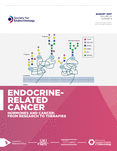Synthetic lethality: the road to novel therapies for breast cancer
- 1Fred Hutchinson Cancer Research Center, Seattle, Washington, USA
- 2The CRUK Gene Function Laboratory and Breast Cancer Now Toby Robins Research Centre, The Institute of Cancer Research, London, UK
- Correspondence should be addressed to C J Lord or T Taniguchi; Email: chris.lord{at}icr.ac.uk or ttaniguc{at}fredhutch.org
-
Figure 1
Oncogene addiction and synthetic lethality. Oncogene and tumour suppressor gene mutations drive the oncogenic process. In addition to driving the oncogenic process, alterations in oncogenes and tumour suppressor also impart a distinct set of genetic dependencies on tumour cells that are not present in normal cells, which are known as oncogene addictions, non-oncogene addictions and synthetic lethal effects. (A) Oncogene addiction is the situation where a tumour cell becomes totally dependent on the activity of a mutated gene (Gene A is shown as an example). An analogous scenario, known as non-oncogene addiction, exists when tumour cells with an alteration in an oncogene A become addicted to the activity of a non-oncogene, B. (B) Synthetic lethality is a scenario in which loss of either gene A or gene B function is tolerated but simultaneous loss of both genes is not. In normal cells, inhibition of either A or B does not result in cell death. In tumour cells in which gene B is rendered dysfunctional (for example by mutation), inhibition of gene A results in cell death.
-
Figure 2
DNA lesions causing replication fork collapse. A working model of the DNA damage response (DDR) to replication fork stalling agents is shown. Drug-like PARP inhibitors trap PARP on DNA. Likewise, topoisomerase poisons trap topoisomerase enzymes on DNA. Platinum salts cause DNA crosslinks. Each of these events stalls the progression of replication forks in S phase. Stalled forks often collapse, forming double-strand DNA breaks. DSBs in this setting are often cytotoxic if not repaired. The normal DNA repair process, homologous recombination, is controlled by BRCA1 and BRCA2. BRCA1 function is required for the processing of DNA ends before repair, a process known as end resection. Once end resection is complete, BRCA2 localises the key DNA recombinase enzyme, RAD51, to DNA at the site of DNA damage. The binding of RAD51 to DNA allows damaged DNA to invade an intact DNA double helix with homologous DNA sequence to that at the site of DNA damage (often in the sister chromatid), which is used as a template on which new DNA could be synthesised as part of the DNA repair process. In the absence of functional BRCA1 and BRCA2, cells either fail to effectively repair DNA (which can lead to apoptosis) or to use orthogonal DNA repair processes such as non-homologous end joining, which increase the frequency of complex DNA rearrangements, events that ultimately impair the fitness of cells.
-
Figure 3
Mechanisms of PARP inhibitor resistance in BRCA1/2-associated cancers. Loss of PARP inhibitor resistance in BRCA1/2 mutated cancers can occur via (1) restoration of BRCA1/2 function and HR by secondary intragenic BRCA1/2 mutations, expression of hypomorphic BRCA1 alleles, stabilisation of mutant BRCA proteins and demethylation of the BRCA1 promoter; (2) restoration of HR as a result of relief from 53BP1-mediated block on end-resection (only in BRCA1 mutant tumour cells); (3) protection of replication forks, from MRE11-mediated degradation, due to loss of PTIP, CHD4 or PARP1 expression; and (4) increased efflux of PARP inhibitor from cancer cells as a result of increased P-glycoprotein expression.
- © 2016 Society for Endocrinology












